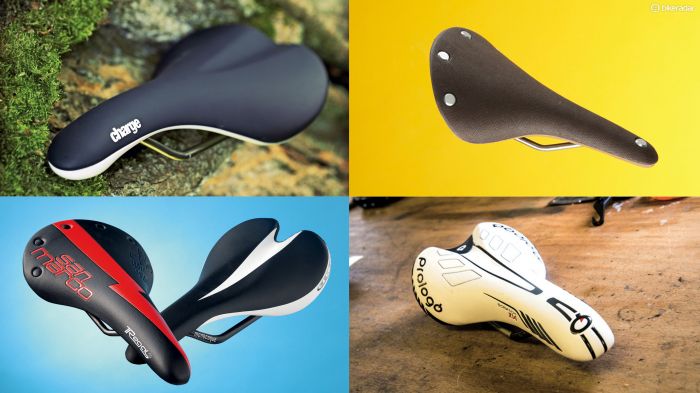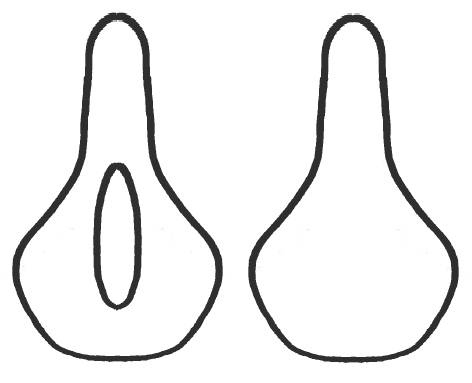Biking hurts? Choose The Right Saddle For You!

Bicycling is supposed to be fun, not painful. Yet, it’s quite common for even somewhat-experienced cyclists to tolerate saddle discomfort believing it’s simply an inevitable part of the sport. Wrong! On the right saddle, you’ll be able to enjoy even lengthy rides while hardly noticing your seat at all.
It is true that most brand-new riders or those getting back into cycling, experience a little soreness on the first rides, yet that feeling normally goes away after a few weeks of regular riding as your body gets used to this new activity.
If it doesn’t, and if you’re suffering every time you hit the road or trail, it’s very likely that you’re riding on a seat that’s not right for you.
The first step, is ensuring that you’re on the right type of saddle for how you ride. There are three basic riding positions, with three corresponding seat types:
Upright Riding Position

Ideal Saddle Type: Cruiser saddle
Features: Very wide, fully padded, may include springs or gel
Ideal Riding Style: Casual, leisurely, slow pedaling cadence
Notes: Notice how the rider has almost all of his weight resting over the seat. This makes the wide saddle shown perfect because it offers an ample platform for support and includes plush padding to cushion most of his body weight. Plus, this cyclist pedals at a leisurely to slow pace with his feet slightly ahead of his body, so a little extra seat width doesn’t interfere with leg movement.
Regular Riding Position

Ideal Saddle Type: Sport Men’s and Women’s models
Features: Anatomic/ergonomic design, may have cutout in top, medium padding (maybe gel), narrow nose, width of rear should match your sit-bone width
Ideal Riding Style: Fitness, commuting, pledge rides, touring, all-around road and trail use, medium to fast pedaling cadence
Notes: For recreational riding where you sit upright and lean slightly forward transferring some of your weight to the pedals and handlebars, a medium to narrow saddle with an ergonomic design and a moderate amount of padding is usually best. Riding this type of bicycle you maintain a fast pedal rate and appreciate less width in the nose so it won’t interfere with your thighs.
Pro Riding Position

Ideal Saddle Type: Racing Men’s or Women’s models
Features: The narrowest and lightest seats, lightly padded, sometimes feature cutouts in the tops, rear width matches your sit bones, may be anatomic/ergonomic
Ideal Riding Style: Fast, fitness, fun, century, race, fast pedaling cadence
Notes: Cyclists who ride fast and hard or for competition require seats suited to their forward position and rapid pedal cadence. Notice how the rider has much of her weight over the handlebars and pedals. She’s so far forward you can see that she’s resting near the middle of the saddle, too. This means less weight is on the seat, which is why these riders can get by with such minimal designs. Also, it’s the perfect position for fast pedaling, for which a narrow saddle like this is ideal.
Based on physical measurements in the lab and on the road, together with valuable feedback from athletes, here are a couple of rules for selecting a road saddle.
First some disclaimers
- These rules aren’t really rules! They’re really concepts which can help provide a framework for understanding how to choose a saddle to minimize discomfort along the body’s midline.
- Position. The rules assume a normal road bike riding position; they don’t work if your torso is very low, e.g. aggressive TT or tri bike positions, or even some extremely slammed road bike positions.
- Good shorts. Not really part of the rules, but of course very important for comfort on the saddle.
Here are the rules in a nutshell. The saddle should be:
- Wide enough

Exaggerated illustration of a pelvis on a saddle that’s too narrow (left) and a saddle that’s wide enough to support the sit bones (right).
![Saddle width2]()
One rule of thumb is that the saddle’s seating surface should be equal or greater than the center-to-center spacing between your sit bones, plus about 1 centimeter on each side. - Flat enough

Exaggerated illustration showing a highly curved saddle (left) and a flatter saddle (right). You can see the curved saddle decreases clearance under the pubic bone compared the increased clearance on the flatter saddle. - Firm enough
![Saddle firm]()
Exaggerated illustration showing a highly padded saddle (left) and a firmer saddle (right). You can see the overpadded saddle decreases the clearance under the pubic bone compared to the increase in clearance on the firmer saddle. - Maybe a cutout

Even on a saddle that’s wide enough, flat enough and firm enough, some people just need a cutout, or a hole through the saddle. If you have a saddle that’s wide enough, flat enough and firm enough and it’s still uncomfortably pressing on the soft tissue under your pubic bone, then you may need a cutout. - T or pear shaped
![Saddle form]()
Athletes who move forward and back a lot on the saddle sometimes prefer a more pear-shaped saddle. On the other hand, athletes who ride a wider saddle often prefer a more T-shaped saddle. Some riders find that a T shaped saddle can reduce chafing on the inner thighs. But there are no hard and fast rules for saddle shape yet.
These rules have helped many riders improve the comfort of their saddles. First, if you choose a saddle that’s wide enough to support your sit bones, and second, it’s flat enough (side to side) that it doesn’t wedge up in the middle and flat enough (front to back) that you don’t slide forward; third, firm enough that you don’t sink in and squish the saddle’s padding up too much in the middle, and fourth, decide whether you need a cutout or not, and finally, consider how “T” or “pear” shaped you prefer, then you’re probably most of the way to enjoying riding your bike in better comfort.




Comments are closed.